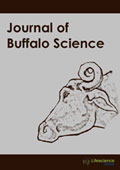jbs
Abstract - River Buffalo Meat Production and Quality: Sustainability, Productivity, Nutritional and Sensory Properties
|
|
Abstract: One of the most important challenges facing today’s society is feeding a growing world population. This review aims to examine the available information to assess the potential of river buffalo as a meat producer with a focus on the sustainability of the supply chain and on meat quality in terms of nutritional and sensory properties. Traditionally, buffalo meat came from old, culled animals in rural agricultural regions where animals were slaughtered at the end of their productive life as dairy or draught animals. Therefore, the meat had low quality. However, when younger animals are used, buffalo meat is generally well appreciated by consumers. Buffaloes can adapt to different production systems and convert poor-quality high fiber feedstuffs into high-quality products, including meat, with a lower degree of competition with human nutrition. In addition, although requiring more land, extensive production systems may have lower environmental impacts due to the low inputs used in the productive process and show higher levels of animal welfare. Although weight gains and dressing percentages are generally lower than in cattle, the meat is characterized by better nutritional properties (low fat and cholesterol contents, high-quality protein, and unsaturated fatty acids). In addition, the use of appropriate production systems might improve its sensory properties. Therefore, buffalo meat may be considered a good option to meet the increasing demand for food for human consumption. Keywords: River buffalo, meat, rearing systems, sustainability, performance, nutritional quality, sensory properties. |
Abstract : Scientific Findings on the Quality of River Buffalo Meat and Prospects for Future Studies
|
|
Abstract: The objectives of this review are to detect scientific findings and areas of opportunity in the study of river buffalo meat from primary production through commercialization and to establish future areas of research linked to each step of the meat supply chain to strengthen and improve the production and quality of buffalo meat in the future. Recent studies show that buffalo meat is healthy and that the prevalence of cardiovascular and cerebrovascular diseases is not related to intramuscular fat consumption. The current grand demand for food constitutes an ongoing challenge for agricultural production. Of course, this demand includes meat, but the animal species traditionally destined for human consumption are no longer capable of satisfying requirements. This review detected gaps in studies of the alimentary systems of this species (including its digestive tract) and a paucity of analyses designed to determine the optimum slaughtering age. Identifying –and correcting– practices that foster contamination, reduce the shelf life of buffalo meat, and suggest appropriate conservation and packaging methods during commercialization are two additional pending concerns. This study concludes that marketing buffalo meat represents a great challenge for producers and researchers, one that requires a multi- and interdisciplinary approach that examines in detail every step of the productive chain. Keywords: Bubalus bubalis, sensory analysis, food safety, nutritional, healthy, human consumption, conservation, packaging, authenticity. |
Abstract : An Approach for Dairy Buffalo Development through Investment in Genetic Improvement
|
|
Abstract: Dairy products are an essential source of animal protein, particularly for nutritional vulnerable groups and vegetarians in Asian countries. Therefore, the approach towards increasing the domestic supply of milk is to raise the buffalo milk yield via genetic improvement from the semen of the selected buffalo sire that possesses a high predicted milk difference. Data were collected from Artificial Insemination Centers in Egypt, as a case study, to apply a dynamic mathematical investment model for estimating the rate of return (IRR) to genetic investment. The effective variables in IRR, besides the economic variables, are the reproductive traits and feed efficiency. The estimated most probable level of IRR was feasible, i.e., 19.71%. A worse change in the reproductive efficiency variables, i.e., the aggregate of 10% increase in the number of conception services, age at the First Calving, and the service period, would decrease the IRR by 7.51%. A decrease in feed efficiency by 10% would decrease the IRR by 9%. A worse change by 10% in the feed costs, price of semen, and milk price would decrease IRR by 7%. To import buffalo sires' semen of high predicted milk difference at moderate prices till establishment, domestic genetic merit is required. Keywords: Dairy buffalo, Feeds, Genetic improving, Investment model, Reproductive traits. |
Abstract : Possible Mutations Expressed in Double Musculature Phenotype
|
|
Abstract: Since the 19th century, the presentation of bovines with disproportionate muscle development have been associated with mutations that inhibit the action of the myostatin gene, it is referred to as double muscle mutation, which is common in some European Bos taurus breeds but it is not reported in buffaloes Bubalus bubalis. This study aims to evaluate if the phenotype observed in 6 young buffaloes with disproportionate muscle development has the same myostatin mutation reported in cattle. DNA was obtained from the blood of the animals of the Murrah breed. First, second and third exon was amplified end point PCR; the fragments were sequenced using capillary electrophoresis. Holstein cattle (Bos taurus) was used As control for normal phenotype. The results obtained from the comparison of the sequence of the myostatin gene show that the observed double-muscled phenotype did not show differences from normal controls. Interspecific variation was demonstrated by comparing exons two and three of the gene, finding 12 variations between the Bos taurus and Bubalus bubalis species in the evaluated fragments. It is necessary to study physiology, and the animals to explain the phenotype observed in buffaloes. Keywords: Myostatin, mutation, double muscle, muscle hyperplasia, Bubalus bubalis. |






















